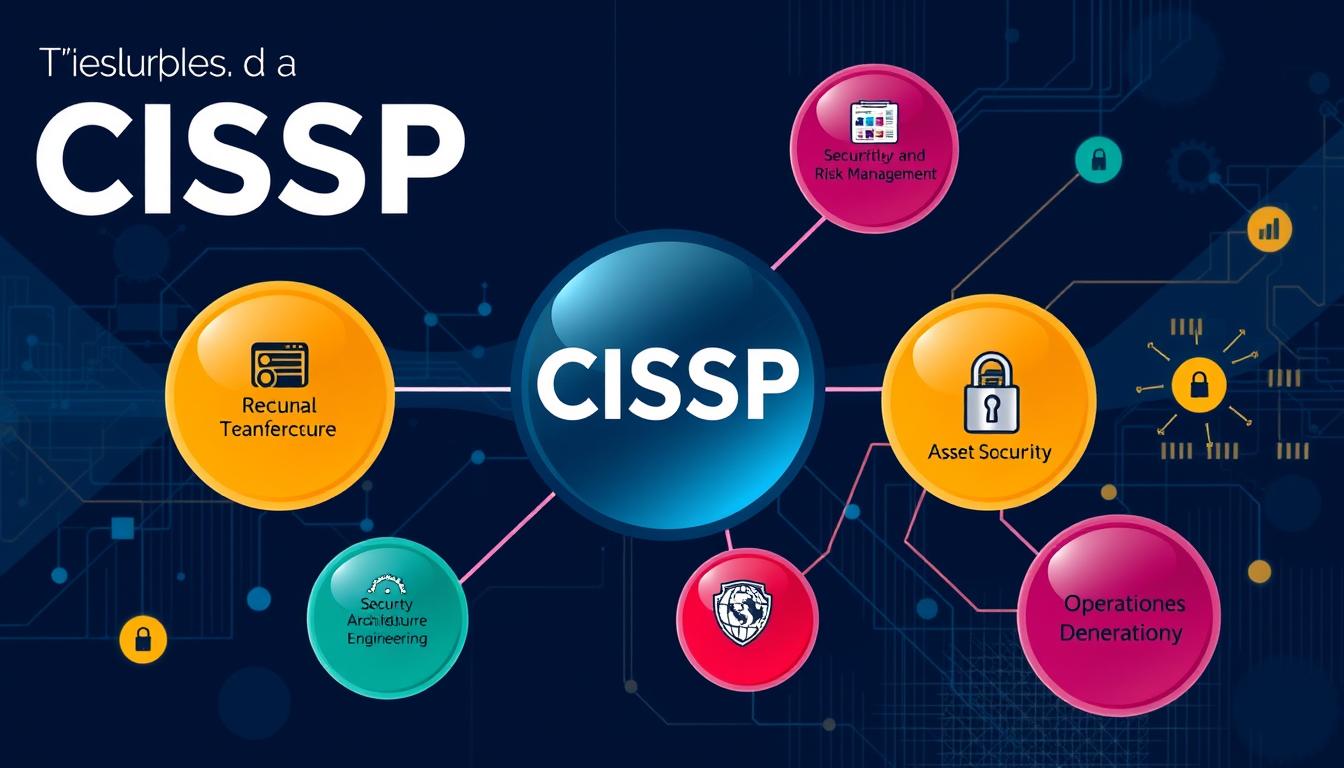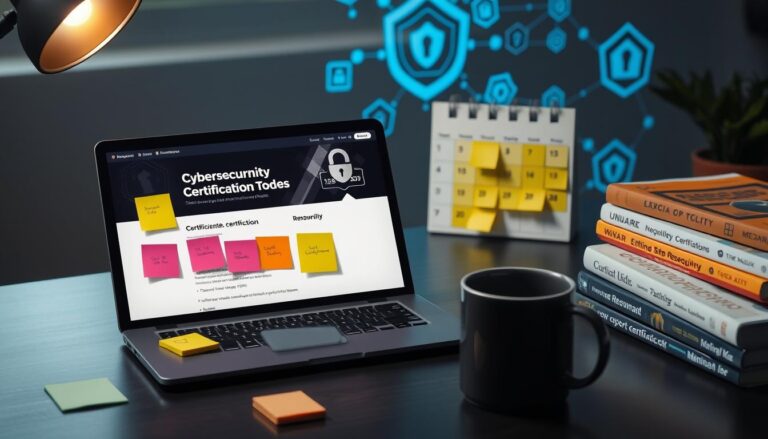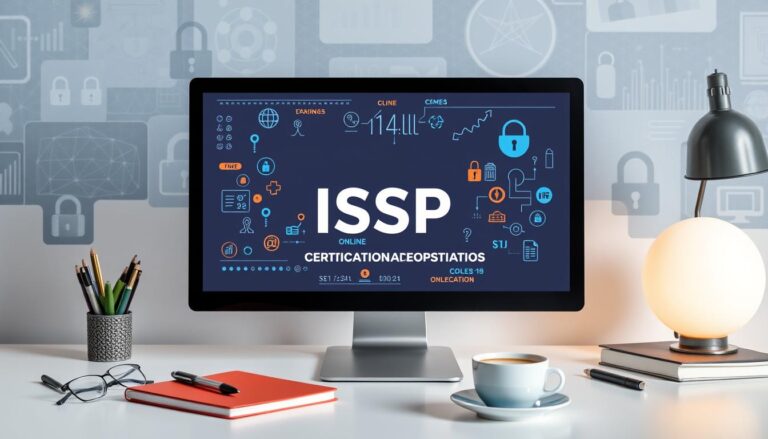
Did you know the CISSP certification is recognized worldwide? It was the first to meet the ANSI/ISO/IEC Standard 17024 in information security. Getting this certification can lead to many career opportunities. To pass, you need to know the eight key CISSP domains well.
The CISSP exam is well-designed. Each domain has a certain percentage of the total score. For instance, Domain 1, on Security and Risk Management, is about 16% of the exam. Knowing these domains boosts your information security skills and prepares you for cyber security challenges.
Exploring each CISSP domain will give you important insights. These insights will help you on your path to this esteemed certification.
Understanding the Importance of CISSP Domains
The importance of CISSP domains goes beyond just getting certified. These domains are key areas of knowledge for IT security pros. They cover essential topics that CISSP candidates need to know. Knowing the CISSP domains helps you create strong security programs for the changing cyber world.
CISSP has been a top cybersecurity certification for over 25 years. When you prep for the CISSP exam, you’ll learn about eight main domains. These include Security and Risk Management, Asset Security, and more. Each domain’s weight shows how important it is in real-world security.
Knowing how the exam is set up is key to studying well. For example, Security and Risk Management makes up 16% of the exam. Other areas like Security Architecture and Identity and Access Management each count for 13%. This info helps you plan your study time better, covering all important topics.
The need for skilled cybersecurity workers is huge, with a shortage of 4 million. Knowing the CISSP domains is critical. It boosts your skills in protecting IT assets and makes you more attractive in the job market. Mid-level CISSP jobs can pay around $151,860.
In short, understanding CISSP domains is essential for a career in cybersecurity. Preparing well for the CISSP exam with deep knowledge of these areas strengthens your career in information security and IT security.
What Are the CISSP Domains?
The CISSP domains are a key part of the CISSP Common Body of Knowledge (CBK). They act as a guide for cybersecurity professionals. These domains cover the main areas you need to know for the CISSP exam.
This detailed approach helps you get ready for the information security field. It makes sure you’re well-prepared for the demands of the job.
Overview of the CISSP Common Body of Knowledge (CBK)
The CISSP Common Body of Knowledge has eight important domains. Each one deals with critical topics in cybersecurity:
- Security and Risk Management
- Asset Security
- Security Architecture and Engineering
- Communication and Network Security
- Identity and Access Management (IAM)
- Security Assessment and Testing
- Security Operations
- Software Development Security
Knowing these domains is essential for passing the CISSP exam. You’ll learn about the CIA triad, risk assessment, secure system design, and incident response.
Exam Objectives
The CISSP exam objectives are key to getting your CISSP certification. Each domain has a specific percentage of the exam, showing its importance:
| Domain | Percentage of Exam |
|---|---|
| Security and Risk Management | 15% |
| Asset Security | 10% |
| Security Architecture and Engineering | 13% |
| Communication and Network Security | 14% |
| Identity and Access Management | 13% |
| Security Assessment and Testing | 12% |
| Security Operations | 13% |
| Software Development Security | 10% |
These percentages show where to focus your studies. Getting your CISSP certification boosts your knowledge and career in cybersecurity.
CISSP Domain 1: Security and Risk Management
CISSP Domain 1 is all about the basics of Security and Risk Management. It’s the starting point for security experts. It covers governance compliance and how to manage risks well. To get certified, you need to know the key rules and frameworks that guide security plans in companies.
Governance and Compliance
Good governance in security means aligning security goals with business aims. Research shows that companies with aligned security plans do better by 30%. Almost 75% of businesses must follow strict security rules due to laws and regulations.
The ISC2 Code of Professional Ethics is key for ethical behavior in companies. Following this code is a must for getting certified. Companies that handle legal, privacy, and audit well are 50% more likely to follow rules. This boosts their risk management efforts.
Risk Management Concepts
Knowing how to manage risks is key to protecting what’s important in a company. The Risk Assessment Process includes steps like finding assets, threats, and vulnerabilities. These steps help spot risks well.
For example, strong security plans can cut cyberattack chances by up to 60%. This shows the value of being proactive. Companies can choose from different ways to deal with risks, like reducing, avoiding, or transferring them. This lets them fit their defense plans to the risk level.
| Key Aspect | Impact |
|---|---|
| Professional Ethics | Links ethical behavior to organizational policies |
| Security Governance | Reduces security breaches by 40% |
| Risk Assessment Steps | Identifies risks through structured analysis |
| Cybercrime Growth | Over 300% increase in incidents year-over-year |
| Compliance Rate | Organizations integrated with legal frameworks achieve 50% higher compliance |
CISSP Domain 2: Asset Security
CISSP Domain 2 focuses on asset security, making up about 10% of the exam. It teaches you how to protect an organization’s information assets. You’ll learn about data classification, handling procedures, and data security solutions.
Data Classification and Handling Procedures
Data classification is key to protecting information. Data is often sorted into levels like Public, Sensitive, Private, and Confidential. This sorting tells us how to handle, store, and secure the data.
Many struggle with their data classification systems. They need the right tools, clear procedures, and ongoing training. A good system protects data in different states with specific security measures.
Data Security Solutions
Effective data security solutions are vital for keeping information safe. Different methods are used for data in different states. For data at rest, encryption, access controls, and backups are important.
For data in transit, end-to-end encryption and onion networking are used. Data in use is protected with homomorphic encryption and Digital Rights Protection. Data Loss Prevention (DLP) strategies also play a big role in monitoring and protecting data.
Organizations must follow laws like GDPR and HIPAA. These laws have strict data retention rules and big fines for breaking them. A risk-based approach to security helps use resources well and builds trust with customers.
CISSP Domain 3: Security Architecture and Engineering
The third domain of CISSP focuses on creating and maintaining secure systems. It makes up 13% of the exam and teaches how to build systems that can fight off cyber threats. Knowing the basics of secure architecture is key to a strong career in cybersecurity.
Key Principles of Secure Architecture
Architecture engineering has several key principles for security. These include:
- Least Privilege: Users should only have the minimum access necessary for their role.
- Defense in Depth: Implement multiple layers of security to protect sensitive components.
- Zero Trust: Never automatically trust any user, whether inside or outside the organization.
These principles help create strong security measures. The CIA triad—Confidentiality, Integrity, and Availability—forms the basis of 80% of security architectures worldwide. By following these, organizations can take a structured and thorough approach to cybersecurity.
Importance of Cryptography
Cryptography is vital for protecting data in transit and at rest. It’s a key part of risk management, helping to reduce data breaches by 58%. Using cryptography and secure coding can also cut software-related incidents by 40%.
More companies are using threat modeling and vulnerability assessments. About 70% of organizations do vulnerability assessments every year. Penetration testing is used by around 65% to check security measures. These practices, along with a deep understanding of security architecture, help defend against cyber threats. As you dive into this domain, learning these concepts will improve your ability to create secure systems.
CISSP Domain 4: Communication and Network Security
CISSP Domain 4 focuses on Communication Security and network security design. It makes up about 13% of the CISSP exam. This domain shows how vital it is to keep communications safe and private in networks. With new threats popping up all the time, knowing how to protect data is key.
Secure Network Design
A good network security design is key to keeping information safe. Important parts of this design include:
- Using secure protocols like Kerberos, SSL, TLS, SFTP, SSH, and IPSec.
- Setting up Network Access Control (NAC) devices, including firewalls and intrusion systems.
- Using micro-segmentation with SDN, VXLAN, and SD-WAN.
- Setting Quality of Service (QoS) levels to make sure voice data gets priority.
Protection Against Network Threats
Strong strategies are needed to fight off network threats:
- Knowing about network topologies like bus, tree, star, mesh, and ring. The star topology is a single point of failure.
- Using methods like token-based collision avoidance and CSMA to manage collisions.
- Using unicast, multicast, and broadcast to make data flow smoothly.

CISSP Domain 5: Identity and Access Management (IAM)
Identity and Access Management is key to keeping sensitive data safe. It’s important because 74% of breaches come from human mistakes. Knowing IAM controls helps prevent these risks.
It’s also vital to understand different ways to check who can access your systems. This is more important than ever with cloud services and federated identities.
Control Mechanisms for Data Access
Good IAM keeps your data safe and available. Identity Management (IdM) solutions help manage user identities across different resources. They follow strict access policies.
Role-Based Access Control (RBAC) makes managing data access easier. It bases permissions on user roles. Regular checks and certifications keep access levels right and follow security rules.
Authentication and Authorization Techniques
Many ways protect data, like username-password combos and Single Sign-On. Biometric methods offer better security and ease for users. Knowing about OpenID Connect, SAML, and RADIUS is important for CISSP candidates.
Fast IdM systems are better. They help users log in and access data quickly and smoothly.
CISSP Domain 6: Security Assessment and Testing
This domain makes up 12% of the CISSP exam. It focuses on the importance of proactive security steps. You’ll learn about different ways to check and test security controls in an organization. Knowing how to do vulnerability testing and security audits helps improve an organization’s security.
Vulnerability Assessment Techniques
Vulnerability assessments find weaknesses in systems that could be used by attackers. There are different types of tests, like internal, external, and third-party audits. Automated tools make these tests faster, taking from minutes to days to complete. Here are some common methods:
- Static Application Security Testing (SAST): Reviews 100% of the source code without running the application.
- Dynamic Application Security Testing (DAST): Tests how applications behave while running.
- Fuzz Testing: Uses random data to see how applications react, showing vulnerabilities well.
- Black Box Testing: Done without seeing the source code, while White Box Testing uses source code access.
Test coverage analysis uses the formula: amount of code covered / total amount of code in application. This helps understand how thorough your tests are.
Auditing Security Controls
Regular audits are key for checking compliance and keeping security controls effective. Internal audits happen often, while external audits might be quarterly or as needed. Third-party audits follow a set schedule for fairness.
| Audit Type | Frequency | Purpose |
|---|---|---|
| Internal Audits | Frequent | Continuous monitoring and compliance |
| External Audits | Quarterly or as needed | Assessment by neutral parties |
| Third-party Audits | Scheduled for neutrality | Ensure compliance and security objectivity |
Breach attack simulations, updated in 2021, test your environment against real attacks. Regular checks boost your defense against cyber threats. They also help meet regulations and standards. This proactive method is key to avoiding legal risks, which can cost 3% to 5% of your revenue.
CISSP Domain 7: Security Operations
Security operations cover the key steps to keep an organization’s data safe. This part of the CISSP exam is big, making up 13% of it. It deals with important topics like how to handle security incidents and manage operations.
You’ll learn about essential security steps. These help protect against many threats.
Incident Response Procedures
Good incident response is key in security operations. It’s about handling security issues in a planned way. This includes looking into incidents, collecting evidence, and doing digital forensics.
Here are some important steps:
- Preparation: Setting up an incident response team and getting ready.
- Identification: Spotting and reporting security issues.
- Containment: Stopping the issue from getting worse.
- Eradication: Fixing the main problem.
- Recovery: Getting systems back to normal.
- Lessons Learned: Learning from the incident to do better next time.
Operational Security Management
Operational security management keeps security efforts working well. It includes several parts:
- Vulnerability Management: Finding and fixing new security holes.
- Log Management: Keeping logs for security analysis by SIEM systems.
- Patch Management: Using systems to automatically apply important updates.
- Change Management: Making sure changes don’t risk security.
A good plan uses User and Entity Behavior Analytics (UEBA). It helps spot unusual behavior, like banks do for fraud.
CISSP Domain 8: Software Development Security
Understanding Software Development Security is key, making up 11% of the CISSP exam. It’s about adding security steps at every stage of the software life cycle. This helps prevent weaknesses in apps and info systems.
Integration of Security in the Software Development Life Cycle
Security is vital at every SDLC stage. Old methods needed approvals at each step. Now, Agile methods focus on speed and quality, leading to DevSecOps. This means security is part of the project from the start.
Best Practices for Secure Coding
Secure coding is essential to lower risks. Static Application Security Testing (SAST) finds code issues early. Dynamic Application Security Testing (DAST) spots problems later. Using VDIs helps protect systems against threats.
Good Software Development Security uses the Capability Maturity Model Integration (CMMI). It helps improve security processes. Tools like IDEs and CI/CD ensure code quality and security throughout development.
| Methodology | Description |
|---|---|
| Waterfall | A linear approach with defined stages requiring approval. |
| Agile | A fast-paced development strategy focusing on iterative progress. |
| DevSecOps | Integrates security from the start of the development process. |
| SAST | Automated scanning of static code for vulnerabilities. |
| DAST | Identifies vulnerabilities post-development. |
| Canary Testing | Deploys changes to a small user subset for feedback. |
| Smoke Testing | Initial tests focused on the application’s critical functionalities. |
Following secure coding practices and adding security to the SDLC is key. It’s the foundation for strong software development security in today’s fast-changing digital world.
Preparing for the CISSP Exam
To pass the CISSP exam, you need to know the exam format and how to study well. Starting April 15, 2024, the CISSP exam will only be in the Computerized Adaptive Testing (CAT) format. This format changes the number of questions based on how you do, making it more challenging. You have three hours to finish the exam, so being well-prepared is key.
Effective Study Strategies
Good study strategies mix regular study habits with active learning. Here are some tips:
- Study regularly to cover all eight domains well.
- Start with foundational certifications like CompTIA Security+ or CCNA Security. They help you understand cybersecurity basics.
- Use ISC2’s instructor-led or on-demand training courses. They fit your learning style.
Utilizing CISSP Practice Questions
Using CISSP practice questions can really help your exam skills. Practice exams mimic the real test and help you get used to the question types. Doing practice questions often helps you:
- Find areas you need to work on more.
- Get better at managing your time, which is important with only three hours.
- Stay focused for the whole exam.
The Role of CISSP Domains in Cyber Security
The CISSP certification has eight domains that are key to a successful cyber security career. Knowing these domains can greatly impact your career, making sure your skills match what employers need. With more jobs in cyber security, having these skills makes you more attractive and effective in your role.
Impact on Career Progression
Being good at the CISSP domains can help you move up in your career fast. Employers want people with IT security expertise, and the CISSP shows you’re serious about it. You need five years of experience in at least two areas to get certified, which is a big step up.
In the U.S., CISSP-certified people make about $136,000 a year on average. This shows how well the certification can pay off.
Valuable Skills Acquired Through CISSP Domains
The CISSP domains teach you many important skills for information security advancement. You learn about:
- Securing risks and managing compliance effectively
- Implementing data security protocols and asset security measures
- Leveraging cryptography in security architecture
- Establishing robust communication and network security practices
- Managing identity and access controls
- Conducting thorough security assessments and audits
- Developing incident response strategies and operational security protocols
- Integrating security into the software development life cycle
These skills not only improve your cyber security skills but also prepare you for the challenges security pros face today.

Conclusion
The CISSP certification is a key asset for those aiming to excel in information security. It covers eight distinct domains, giving you the knowledge needed to tackle today’s cyber threats. Mastering these areas prepares you for the CISSP exam and boosts your career in the industry.
The exam tests your grasp of key concepts, requiring a score of 700 out of 1000. It has 125-175 questions and lasts 4 hours. The training you get is vital for gaining practical skills in the CISSP domains. This prepares you for new roles in the ever-changing cyber security field.
With the need for skilled info security professionals on the rise, CISSP certification makes you stand out. You’ll show expertise in areas like Security Operations and Identity and Access Management. This makes you a valuable asset to any company looking to improve its security.
Source Links
- CISSP Common Body of Knowledge (CBK): The 8 Domains Explained
- CISSP Exam Outline
- CISSP domains overview (2024) | Essential information
- The 8 CISSP Domains Explained [2025 Updated] With Exam Tips
- Master the 8 CISSP Domains: A Must-Read for Security Professionals
- What Are the 8 Domains of CISSP?
- Everything You Need To Know About The 8 CISSP Domains – BridgingMinds Network
- Certified Information Systems Security Professional
- Unraveling CISSP Domain 1: Security and Risk Management
- CISSP – Certified Information Systems Security Professional | ISC2
- The Fundamentals of CISSP Domain1: Security and Risk Management
- Asset Security in CISSP Domain 2: Essential Insights for Exam Preparation
- Understanding CISSP Domain 2: Asset Security
- CISSP domain 2: Asset security – What you need to know for the Exam [updated 2021]
- CISSP Domain 3: Security Architecture and Engineering Demystified
- Domain3: Understanding Security Architecture and Engineering in CISSP
- CISSP Domain 3: A Comprehensive Security Architecture Guide
- CISSP domain 4: Communications and network security — What you need to know for the exam [2022 update]
- CISSP Domain 4 – A Guide to Communication and Network Security
- Understanding CISSP Domain 5: Identity and Access Management
- CISSP domain 5: Identity and access management — What you need to know for the exam [Updated 2022]
- A Guide to CISSP Domain 6: Security Assessment & Testing
- CISSP domain 6: Security assessment and testing — What you need to know for the exam [Updated 2022]
- Explore CISSP Domain 6: Security Assessment and Testing
- CISSP domain 7: Security operations — What you need to know for the exam [Updated 2022]
- Insights into CISSP Domain 7: Security Operations
- Keeping Systems Secure: A Guide to CISSP Domain 7 Security Operations
- Master CISSP Domain 8: Secure Software Development Insights
- Software Development Security in CISSP Domain 8: What’s New in 2023?
- How to Pass The CISSP Exam in Your First Attempt
- Preparing for the ISC2 CISSP Exam
- The Eight Domains You Need to Know About and Master So You Can Pass Your CISSP Certification Exam
- CISSP Roles and Responsibilities | Cybrary
- 8 CISSP Domains Explained to Ace Exam in 2025
- Understanding the Eight Domains of CISSP: A Deep Dive



